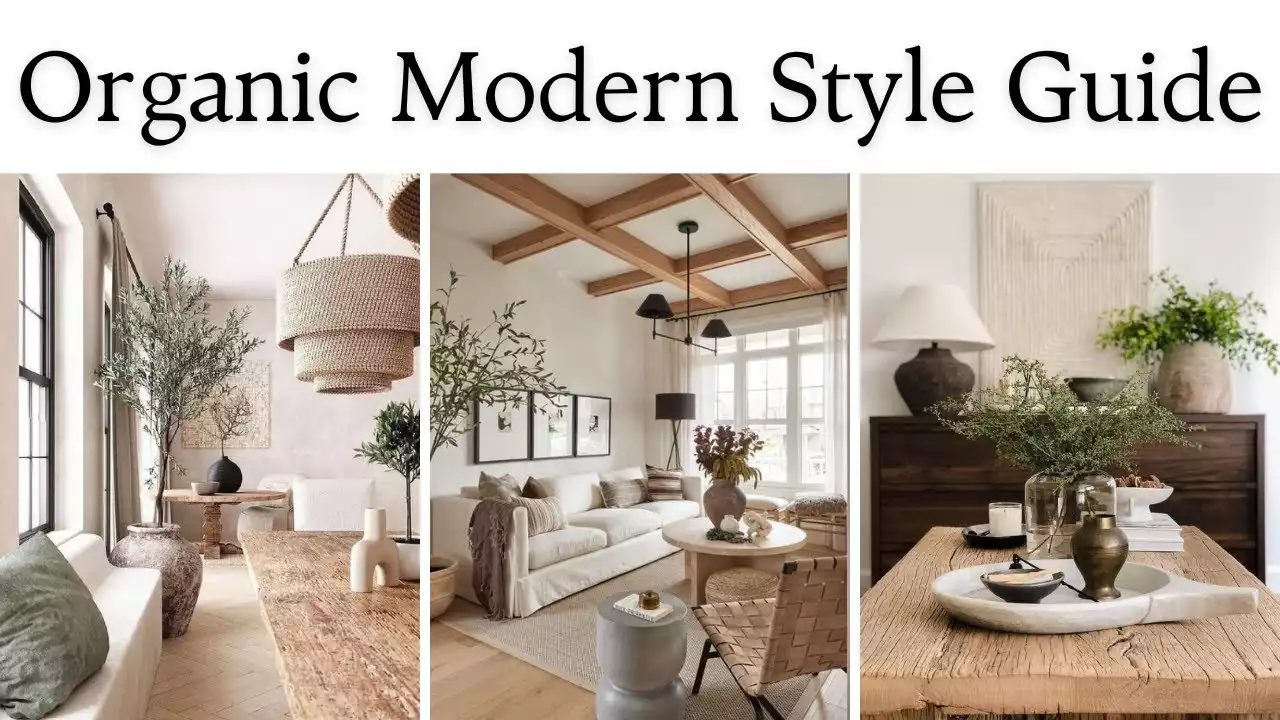In a fast-paced world filled with fleeting trends, organic modern interior design offers a breath of fresh air with its timeless elegance. This design style seamlessly blends natural elements with contemporary aesthetics, creating spaces that are both visually stunning and harmonious. By embracing the beauty of organic materials like wood, stone, and plants, this design approach brings a sense of warmth and tranquility into your home.Organic modern interior design celebrates simplicity and minimalism, focusing on clean lines, uncluttered spaces, and a neutral color palette. It effortlessly combines old and new, traditional and contemporary, to create a balance between nature and modern living. Each piece of furniture and decor is carefully chosen to reflect a connection to the natural world, creating a space that feels grounded and welcoming.Whether you're redesigning your entire home or simply adding organic touches to your existing space, embracing the beauty of organic modern interior design can elevate your living environment to the next level. So why not bring the outside in and create a home that reflects both your personal style and a timeless sense of elegance?
What is organic modern interior design?
Organic modern interior design is a design style that combines the simplicity of modern design with the warmth and beauty of organic materials. It embraces the natural world and seeks to bring it indoors, creating a space that feels connected to nature. This design style is characterized by clean lines, uncluttered spaces, and a neutral color palette, allowing the organic elements to take center stage. It celebrates simplicity and minimalism, creating a space that feels calm and inviting.
Characteristics of organic modern interior design
One of the key characteristics of organic modern interior design is the use of natural materials. Wood, stone, and plants play a central role in creating a sense of warmth and earthiness in the space. Organic shapes and textures are also a common feature, adding depth and visual interest. The design style also focuses on creating a sense of balance between old and new, traditional and contemporary. This balance is achieved through the careful selection of furniture and decor that reflects a connection to the natural world.
Another characteristic of organic modern interior design is the emphasis on clean lines and uncluttered spaces. This design style seeks to create a sense of calm and simplicity, allowing the natural materials to shine. The color palette is typically neutral, with shades of white, beige, gray, and brown dominating the space. This allows the organic elements to stand out and creates a cohesive and harmonious look.
Benefits of organic modern interior design
Embracing organic modern interior design offers a range of benefits. Firstly, it creates a space that feels timeless and elegant. Unlike trendy design styles that come and go, organic modern design has a lasting appeal that transcends time. The use of natural materials and neutral colors creates a sense of tranquility and warmth that never goes out of style.
Secondly, organic modern interior design promotes a sense of well-being. The connection to nature that this design style fosters has been shown to have a positive impact on mental health. Being surrounded by natural materials and elements can reduce stress, increase productivity, and improve overall mood. It creates a space that feels grounded and nurturing, allowing you to recharge and find peace within your own home.
Organic materials in interior design
Organic materials are at the heart of organic modern interior design. Wood, in its various forms, is a key component of this design style. From hardwood floors to reclaimed wood furniture, incorporating wood into your space adds warmth and a natural element. Stone, such as marble or slate, can be used for countertops, backsplashes, or even accent walls, creating a sense of luxury and sophistication.
Plants are another essential element in organic modern interior design. They bring life and freshness into the space, making it feel vibrant and inviting. Whether it's a large statement plant or a collection of small potted plants, incorporating greenery into your space adds a touch of nature and improves air quality.
Color palettes for organic modern interiors
The color palette for organic modern interiors is typically neutral, with a focus on earth tones. Shades of white, beige, gray, and brown form the foundation of the color scheme, creating a sense of calm and serenity. These neutral shades allow the organic materials and elements to take center stage, while also providing a versatile backdrop for different styles of furniture and decor.
To add depth and visual interest to the space, you can incorporate pops of color through accessories and textiles. Warm tones like terracotta, mustard yellow, or deep green can add a touch of personality and create a focal point in the room. However, it's important to use these accent colors sparingly to maintain the overall sense of simplicity and minimalism that is characteristic of organic modern design.
Organic Modern Interior Design Explained: A Step-by-Step Guide
Furniture and decor in organic modern design
When it comes to furniture and decor in organic modern interior design, the focus is on quality over quantity. Each piece is carefully chosen to reflect a connection to the natural world and to create a sense of balance in the space. Furniture with clean lines and simple silhouettes is preferred, allowing the natural materials to shine.
In terms of materials, wood is a popular choice for furniture in organic modern design. Whether it's a beautiful wooden dining table, a sleek walnut coffee table, or a minimalist oak bed frame, incorporating wood furniture adds warmth and authenticity to the space. Other natural materials like leather, linen, and rattan can also be used to add texture and visual interest.
When it comes to decor, organic modern design embraces simplicity. Rather than cluttering the space with unnecessary objects, focus on a few key pieces that have meaning and tell a story. For example, a large statement artwork or a unique handmade ceramic vase can become a focal point and add personality to the room. Plants should also be considered as decorative elements, as they not only bring life into the space but also add a touch of greenery.
Incorporating natural light in organic modern interiors
Natural light is an important element in organic modern interior design. It enhances the beauty of the organic materials and creates a sense of spaciousness and openness in the space. To maximize natural light, it's important to consider the placement of windows and the use of light-colored window treatments that allow light to filter through.
In addition to natural light, artificial lighting plays a crucial role in organic modern interiors. Use a combination of ambient, task, and accent lighting to create layers of light and to highlight specific areas or objects. Choose light fixtures that have a sleek and minimalist design, allowing them to blend seamlessly with the overall aesthetic of the space.
Tips for creating an organic modern space
To create an organic modern space, keep the following tips in mind:
1. Start with a neutral color palette: Use shades of white, beige, gray, and brown as the foundation of your color scheme.2. Embrace natural materials: Incorporate wood, stone, and plants into your space to bring a sense of warmth and nature indoors.3. Focus on clean lines and uncluttered spaces: Create a sense of calm and simplicity by choosing furniture and decor with clean lines and by keeping the space free from unnecessary clutter.4. Let natural light in: Maximize natural light by considering the placement of windows and using light-colored window treatments.5. Choose quality over quantity: Select furniture and decor that reflect a connection to the natural world and that create a sense of balance in the space.6. Add pops of color sparingly: Use accent colors sparingly to maintain the overall sense of simplicity and minimalism.7. Incorporate plants: Bring life and freshness into the space by incorporating plants of different sizes and varieties.
Examples of organic modern interior design
To inspire your organic modern interior design journey, here are a few examples:
1. A living room with a white color palette, a large leather sofa, and a statement wooden coffee table. Potted plants and a floor-to-ceiling window create a sense of connection to the outdoors.2. A kitchen with marble countertops, sleek white cabinets, and a large wooden dining table. Pendant lights with a minimalist design provide both ambient and task lighting.3. A bedroom with a neutral color palette, a platform bed with a wooden frame, and linen bedding. A large abstract artwork and a few carefully chosen decor pieces add personality to the space.
Conclusion
Embracing the beauty of organic modern interior design allows you to create a space that is both visually stunning and timeless. By seamlessly blending natural elements with contemporary aesthetics, you can bring a sense of warmth and tranquility into your home. From incorporating organic materials like wood and stone to choosing furniture and decor that reflect a connection to the natural world, organic modern design celebrates simplicity and minimalism. So why not bring the outside in and create a home that reflects both your personal style and a timeless sense of elegance?


 Join Our Wine Journey In France, Wineries, Tastings And Cheeses
Join Our Wine Journey In France, Wineries, Tastings And Cheeses
 Choose Roasting as a Cooking Method
Choose Roasting as a Cooking Method Exploring the Street Foods of China
Exploring the Street Foods of China Unveiling the Timeless Sophistication of Modern Japanese Interior Design
Unveiling the Timeless Sophistication of Modern Japanese Interior Design